
Illustrative Math Alignment: Grade 6 Unit 1
Dividing Fractions
Lesson 11: Using an Algorithm to Divide Fractions
Use the following Media4Math resources with this Illustrative Math lesson.
| Thumbnail Image | Title | Body | Curriculum Nodes |
|---|---|---|---|

|
Quizlet Flash Cards: Dividing Fractions, Set 08 | Description Divide fractions in this 20-flash card set. Fraction denominators include 2, 3, 4, 5, 6, 8, 10, and 12. Note: The download is the teacher's guide for using Media4Math's Quizlet Flash Cards. Related ResourcesTo see other resources related to this topic, click on the Resources tab above. Quizlet LibraryTo see the complete Quizlet Flash Card Library, click on this Link to see the collection. |
Fractions and Mixed Numbers |

|
Quizlet Flash Cards: Dividing Fractions, Set 08 | Description Divide fractions in this 20-flash card set. Fraction denominators include 2, 3, 4, 5, 6, 8, 10, and 12. Note: The download is the teacher's guide for using Media4Math's Quizlet Flash Cards. Related ResourcesTo see other resources related to this topic, click on the Resources tab above. Quizlet LibraryTo see the complete Quizlet Flash Card Library, click on this Link to see the collection. |
Fractions and Mixed Numbers |

|
Quizlet Flash Cards: Dividing Fractions, Set 07 | Description Divide fractions in this 20-flash card set. Fraction denominators include 2, 3, 4, 5, 6, 8, 10, and 12. Note: The download is the teacher's guide for using Media4Math's Quizlet Flash Cards. Related ResourcesTo see other resources related to this topic, click on the Resources tab above. Quizlet LibraryTo see the complete Quizlet Flash Card Library, click on this Link to see the collection. |
Fractions and Mixed Numbers |

|
Quizlet Flash Cards: Dividing Fractions, Set 05 | Description Divide fractions in this 20-flash card set. Fraction denominators include 2, 3, 4, 5, 6, 8, 10, and 12. Note: The download is the teacher's guide for using Media4Math's Quizlet Flash Cards. Related ResourcesTo see other resources related to this topic, click on the Resources tab above. Quizlet LibraryTo see the complete Quizlet Flash Card Library, click on this Link to see the collection. |
Fractions and Mixed Numbers |

|
Quizlet Flash Cards: Dividing Fractions, Set 10 | Description Divide fractions in this 20-flash card set. Fraction denominators include 2, 3, 4, 5, 6, 8, 10, and 12. Note: The download is the teacher's guide for using Media4Math's Quizlet Flash Cards. Related ResourcesTo see other resources related to this topic, click on the Resources tab above. Quizlet LibraryTo see the complete Quizlet Flash Card Library, click on this Link to see the collection. |
Fractions and Mixed Numbers |

|
Quizlet Flash Cards: Dividing Fractions, Set 09 | Description Divide fractions in this 20-flash card set. Fraction denominators include 2, 3, 4, 5, 6, 8, 10, and 12. Note: The download is the teacher's guide for using Media4Math's Quizlet Flash Cards. Related ResourcesTo see other resources related to this topic, click on the Resources tab above. Quizlet LibraryTo see the complete Quizlet Flash Card Library, click on this Link to see the collection. |
Fractions and Mixed Numbers |

|
Quizlet Flash Cards: Dividing Fractions, Set 04 | Description Divide fractions in this 20-flash card set. Fraction denominators include 2, 3, 4, 5, 6, 8, 10, and 12. Note: The download is the teacher's guide for using Media4Math's Quizlet Flash Cards. Related ResourcesTo see other resources related to this topic, click on the Resources tab above. Quizlet LibraryTo see the complete Quizlet Flash Card Library, click on this Link to see the collection. |
Fractions and Mixed Numbers |

|
Quizlet Flash Cards: Dividing Fractions, Set 09 | Description Divide fractions in this 20-flash card set. Fraction denominators include 2, 3, 4, 5, 6, 8, 10, and 12. Note: The download is the teacher's guide for using Media4Math's Quizlet Flash Cards. Related ResourcesTo see other resources related to this topic, click on the Resources tab above. Quizlet LibraryTo see the complete Quizlet Flash Card Library, click on this Link to see the collection. |
Fractions and Mixed Numbers |

|
Math Example: Fraction Operations--Dividing Fractions: Example 11 | Dividing Fractions: Example 11TopicFraction Operations DescriptionThis example demonstrates the division of fractions by illustrating the conversion of division into multiplication using the reciprocal of the divisor. The visual guide helps learners understand the transformation and the subsequent multiplication process. In this example, the result is a mixed number. Key skills include identifying reciprocal relationships, executing multiplication, and simplifying fractions. This example is instrumental in building a solid understanding of how dividing fractions simplifies into a multiplication problem, enhancing students' problem-solving skills in fraction arithmetic. |
Fractions and Mixed Numbers |
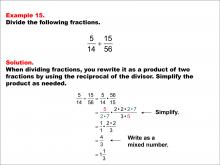
|
Math Example: Fraction Operations--Dividing Fractions: Example 15 | Dividing Fractions: Example 15TopicFraction Operations DescriptionThis example illustrates the division of fractions by converting the operation into multiplication using the reciprocal of the divisor. The image provides a clear step-by-step guide, emphasizing the importance of reciprocal multiplication. The result is a mixed number. Skills involved include recognizing and applying reciprocal relationships, performing multiplication, and simplifying fractions. This example is crucial for understanding the fundamental principle that dividing by a fraction is equivalent to multiplying by its reciprocal, a key concept in fraction operations. |
Fractions and Mixed Numbers |

|
Math Example: Fraction Operations--Dividing Fractions: Example 11 | Dividing Fractions: Example 11TopicFraction Operations DescriptionThis example demonstrates the division of fractions by illustrating the conversion of division into multiplication using the reciprocal of the divisor. The visual guide helps learners understand the transformation and the subsequent multiplication process. In this example, the result is a mixed number. Key skills include identifying reciprocal relationships, executing multiplication, and simplifying fractions. This example is instrumental in building a solid understanding of how dividing fractions simplifies into a multiplication problem, enhancing students' problem-solving skills in fraction arithmetic. |
Fractions and Mixed Numbers |
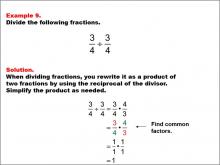
|
Math Example: Fraction Operations--Dividing Fractions: Example 9 | Dividing Fractions: Example 9TopicFraction Operations DescriptionThis example focuses on the division of fractions by utilizing the reciprocal of the divisor. The process is visually depicted, allowing learners to follow the transformation from division to multiplication. Essential skills include understanding the concept of reciprocals, executing multiplication of fractions, and simplifying the final result. In this example the quotient equals 1. This example aids in reinforcing the understanding of how dividing fractions is essentially multiplying by the inverse, a critical concept in fraction arithmetic. |
Fractions and Mixed Numbers |
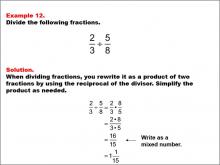
|
Math Example: Fraction Operations--Dividing Fractions: Example 12 | Dividing Fractions: Example 12TopicFraction Operations DescriptionThis example focuses on dividing fractions by converting the division into multiplication using the reciprocal of the divisor. The image visually represents the process, emphasizing the importance of understanding reciprocal operations. In this example the result is a mixed number. Skills involved include recognizing equivalent fractions, performing multiplication, and simplifying fractions to their lowest terms. This example is crucial for students to grasp how division of fractions simplifies into a multiplication problem, enhancing their problem-solving capabilities in fraction arithmetic. |
Fractions and Mixed Numbers |
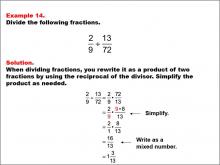
|
Math Example: Fraction Operations--Dividing Fractions: Example 14 | Dividing Fractions: Example 14TopicFraction Operations DescriptionThis example focuses on the division of fractions by utilizing the reciprocal of the divisor. The process is visually depicted, allowing learners to follow the transformation from division to multiplication. The result is a mixed number. Essential skills include understanding the concept of reciprocals, executing multiplication of fractions, and simplifying the final result. This example aids in reinforcing the understanding of how dividing fractions is essentially multiplying by the inverse, a critical concept in fraction arithmetic. |
Fractions and Mixed Numbers |

|
Math Example: Fraction Operations--Dividing Fractions: Example 15 | Dividing Fractions: Example 15TopicFraction Operations DescriptionThis example illustrates the division of fractions by converting the operation into multiplication using the reciprocal of the divisor. The image provides a clear step-by-step guide, emphasizing the importance of reciprocal multiplication. The result is a mixed number. Skills involved include recognizing and applying reciprocal relationships, performing multiplication, and simplifying fractions. This example is crucial for understanding the fundamental principle that dividing by a fraction is equivalent to multiplying by its reciprocal, a key concept in fraction operations. |
Fractions and Mixed Numbers |
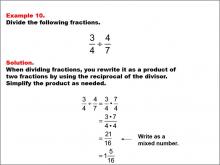
|
Math Example: Fraction Operations--Dividing Fractions: Example 10 | Dividing Fractions: Example 10TopicFraction Operations DescriptionThis example illustrates the division of fractions by converting the operation into multiplication using the reciprocal of the divisor. The image provides a clear step-by-step guide, emphasizing the importance of reciprocal multiplication. In this example the result is a mixed number. Skills involved include recognizing and applying reciprocal relationships, performing multiplication, and simplifying fractions. This example is crucial for understanding the fundamental principle that dividing by a fraction is equivalent to multiplying by its reciprocal, a key concept in fraction operations. |
Fractions and Mixed Numbers |

|
Math Example: Fraction Operations--Dividing Fractions: Example 10 | Dividing Fractions: Example 10TopicFraction Operations DescriptionThis example illustrates the division of fractions by converting the operation into multiplication using the reciprocal of the divisor. The image provides a clear step-by-step guide, emphasizing the importance of reciprocal multiplication. In this example the result is a mixed number. Skills involved include recognizing and applying reciprocal relationships, performing multiplication, and simplifying fractions. This example is crucial for understanding the fundamental principle that dividing by a fraction is equivalent to multiplying by its reciprocal, a key concept in fraction operations. |
Fractions and Mixed Numbers |
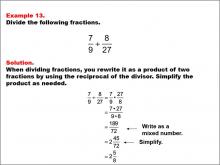
|
Math Example: Fraction Operations--Dividing Fractions: Example 13 | Dividing Fractions: Example 13TopicFraction Operations DescriptionThis example demonstrates the division of fractions by illustrating the conversion of the division operation into multiplication by the reciprocal. The image serves as a guide to understanding the method of flipping the second fraction and multiplying, showcasing the concept of reciprocal multiplication. The result is a mixed number. Key skills include identifying reciprocal relationships, multiplying fractions, and simplifying results. This example is instrumental in helping students understand the mechanics of dividing fractions, which is a pivotal skill in mastering fraction operations. |
Fractions and Mixed Numbers |

|
Math Example: Fraction Operations--Dividing Fractions: Example 13 | Dividing Fractions: Example 13TopicFraction Operations DescriptionThis example demonstrates the division of fractions by illustrating the conversion of the division operation into multiplication by the reciprocal. The image serves as a guide to understanding the method of flipping the second fraction and multiplying, showcasing the concept of reciprocal multiplication. The result is a mixed number. Key skills include identifying reciprocal relationships, multiplying fractions, and simplifying results. This example is instrumental in helping students understand the mechanics of dividing fractions, which is a pivotal skill in mastering fraction operations. |
Fractions and Mixed Numbers |

|
Math Example: Fraction Operations--Dividing Fractions: Example 15 | Dividing Fractions: Example 15TopicFraction Operations DescriptionThis example illustrates the division of fractions by converting the operation into multiplication using the reciprocal of the divisor. The image provides a clear step-by-step guide, emphasizing the importance of reciprocal multiplication. The result is a mixed number. Skills involved include recognizing and applying reciprocal relationships, performing multiplication, and simplifying fractions. This example is crucial for understanding the fundamental principle that dividing by a fraction is equivalent to multiplying by its reciprocal, a key concept in fraction operations. |
Fractions and Mixed Numbers |

|
Math Example: Fraction Operations--Dividing Fractions: Example 14 | Dividing Fractions: Example 14TopicFraction Operations DescriptionThis example focuses on the division of fractions by utilizing the reciprocal of the divisor. The process is visually depicted, allowing learners to follow the transformation from division to multiplication. The result is a mixed number. Essential skills include understanding the concept of reciprocals, executing multiplication of fractions, and simplifying the final result. This example aids in reinforcing the understanding of how dividing fractions is essentially multiplying by the inverse, a critical concept in fraction arithmetic. |
Fractions and Mixed Numbers |
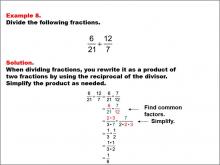
|
Math Example: Fraction Operations--Dividing Fractions: Example 8 | Dividing Fractions: Example 8TopicFraction Operations DescriptionThis example demonstrates the division of fractions by illustrating the conversion of the division operation into multiplication by the reciprocal. The image serves as a guide to understanding the method of flipping the second fraction and multiplying, showcasing the concept of reciprocal multiplication. Key skills include identifying reciprocal relationships, multiplying fractions, and simplifying results. This example is instrumental in helping students understand the mechanics of dividing fractions, which is a pivotal skill in mastering fraction operations. |
Fractions and Mixed Numbers |

|
Math Example: Fraction Operations--Dividing Fractions: Example 9 | Dividing Fractions: Example 9TopicFraction Operations DescriptionThis example focuses on the division of fractions by utilizing the reciprocal of the divisor. The process is visually depicted, allowing learners to follow the transformation from division to multiplication. Essential skills include understanding the concept of reciprocals, executing multiplication of fractions, and simplifying the final result. In this example the quotient equals 1. This example aids in reinforcing the understanding of how dividing fractions is essentially multiplying by the inverse, a critical concept in fraction arithmetic. |
Fractions and Mixed Numbers |

|
Math Example: Fraction Operations--Dividing Fractions: Example 11 | Dividing Fractions: Example 11TopicFraction Operations DescriptionThis example demonstrates the division of fractions by illustrating the conversion of division into multiplication using the reciprocal of the divisor. The visual guide helps learners understand the transformation and the subsequent multiplication process. In this example, the result is a mixed number. Key skills include identifying reciprocal relationships, executing multiplication, and simplifying fractions. This example is instrumental in building a solid understanding of how dividing fractions simplifies into a multiplication problem, enhancing students' problem-solving skills in fraction arithmetic. |
Fractions and Mixed Numbers |

|
Math Example: Fraction Operations--Dividing Fractions: Example 9 | Dividing Fractions: Example 9TopicFraction Operations DescriptionThis example focuses on the division of fractions by utilizing the reciprocal of the divisor. The process is visually depicted, allowing learners to follow the transformation from division to multiplication. Essential skills include understanding the concept of reciprocals, executing multiplication of fractions, and simplifying the final result. In this example the quotient equals 1. This example aids in reinforcing the understanding of how dividing fractions is essentially multiplying by the inverse, a critical concept in fraction arithmetic. |
Fractions and Mixed Numbers |

|
Math Example: Fraction Operations--Dividing Fractions: Example 12 | Dividing Fractions: Example 12TopicFraction Operations DescriptionThis example focuses on dividing fractions by converting the division into multiplication using the reciprocal of the divisor. The image visually represents the process, emphasizing the importance of understanding reciprocal operations. In this example the result is a mixed number. Skills involved include recognizing equivalent fractions, performing multiplication, and simplifying fractions to their lowest terms. This example is crucial for students to grasp how division of fractions simplifies into a multiplication problem, enhancing their problem-solving capabilities in fraction arithmetic. |
Fractions and Mixed Numbers |

|
Math Example: Fraction Operations--Dividing Fractions: Example 14 | Dividing Fractions: Example 14TopicFraction Operations DescriptionThis example focuses on the division of fractions by utilizing the reciprocal of the divisor. The process is visually depicted, allowing learners to follow the transformation from division to multiplication. The result is a mixed number. Essential skills include understanding the concept of reciprocals, executing multiplication of fractions, and simplifying the final result. This example aids in reinforcing the understanding of how dividing fractions is essentially multiplying by the inverse, a critical concept in fraction arithmetic. |
Fractions and Mixed Numbers |

|
Math Example: Fraction Operations--Dividing Fractions: Example 13 | Dividing Fractions: Example 13TopicFraction Operations DescriptionThis example demonstrates the division of fractions by illustrating the conversion of the division operation into multiplication by the reciprocal. The image serves as a guide to understanding the method of flipping the second fraction and multiplying, showcasing the concept of reciprocal multiplication. The result is a mixed number. Key skills include identifying reciprocal relationships, multiplying fractions, and simplifying results. This example is instrumental in helping students understand the mechanics of dividing fractions, which is a pivotal skill in mastering fraction operations. |
Fractions and Mixed Numbers |

|
Math Example: Fraction Operations--Dividing Fractions: Example 12 | Dividing Fractions: Example 12TopicFraction Operations DescriptionThis example focuses on dividing fractions by converting the division into multiplication using the reciprocal of the divisor. The image visually represents the process, emphasizing the importance of understanding reciprocal operations. In this example the result is a mixed number. Skills involved include recognizing equivalent fractions, performing multiplication, and simplifying fractions to their lowest terms. This example is crucial for students to grasp how division of fractions simplifies into a multiplication problem, enhancing their problem-solving capabilities in fraction arithmetic. |
Fractions and Mixed Numbers |

|
Math Example: Fraction Operations--Dividing Fractions: Example 14 | Dividing Fractions: Example 14TopicFraction Operations DescriptionThis example focuses on the division of fractions by utilizing the reciprocal of the divisor. The process is visually depicted, allowing learners to follow the transformation from division to multiplication. The result is a mixed number. Essential skills include understanding the concept of reciprocals, executing multiplication of fractions, and simplifying the final result. This example aids in reinforcing the understanding of how dividing fractions is essentially multiplying by the inverse, a critical concept in fraction arithmetic. |
Fractions and Mixed Numbers |

|
Math Example: Fraction Operations--Dividing Fractions: Example 15 | Dividing Fractions: Example 15TopicFraction Operations DescriptionThis example illustrates the division of fractions by converting the operation into multiplication using the reciprocal of the divisor. The image provides a clear step-by-step guide, emphasizing the importance of reciprocal multiplication. The result is a mixed number. Skills involved include recognizing and applying reciprocal relationships, performing multiplication, and simplifying fractions. This example is crucial for understanding the fundamental principle that dividing by a fraction is equivalent to multiplying by its reciprocal, a key concept in fraction operations. |
Fractions and Mixed Numbers |

|
Math Example: Fraction Operations--Dividing Fractions: Example 14 | Dividing Fractions: Example 14TopicFraction Operations DescriptionThis example focuses on the division of fractions by utilizing the reciprocal of the divisor. The process is visually depicted, allowing learners to follow the transformation from division to multiplication. The result is a mixed number. Essential skills include understanding the concept of reciprocals, executing multiplication of fractions, and simplifying the final result. This example aids in reinforcing the understanding of how dividing fractions is essentially multiplying by the inverse, a critical concept in fraction arithmetic. |
Fractions and Mixed Numbers |

|
Math Example: Fraction Operations--Dividing Fractions: Example 14 | Dividing Fractions: Example 14TopicFraction Operations DescriptionThis example focuses on the division of fractions by utilizing the reciprocal of the divisor. The process is visually depicted, allowing learners to follow the transformation from division to multiplication. The result is a mixed number. Essential skills include understanding the concept of reciprocals, executing multiplication of fractions, and simplifying the final result. This example aids in reinforcing the understanding of how dividing fractions is essentially multiplying by the inverse, a critical concept in fraction arithmetic. |
Fractions and Mixed Numbers |

|
Math Example: Fraction Operations--Dividing Fractions: Example 15 | Dividing Fractions: Example 15TopicFraction Operations DescriptionThis example illustrates the division of fractions by converting the operation into multiplication using the reciprocal of the divisor. The image provides a clear step-by-step guide, emphasizing the importance of reciprocal multiplication. The result is a mixed number. Skills involved include recognizing and applying reciprocal relationships, performing multiplication, and simplifying fractions. This example is crucial for understanding the fundamental principle that dividing by a fraction is equivalent to multiplying by its reciprocal, a key concept in fraction operations. |
Fractions and Mixed Numbers |

|
Math Example: Fraction Operations--Dividing Fractions: Example 15 | Dividing Fractions: Example 15TopicFraction Operations DescriptionThis example illustrates the division of fractions by converting the operation into multiplication using the reciprocal of the divisor. The image provides a clear step-by-step guide, emphasizing the importance of reciprocal multiplication. The result is a mixed number. Skills involved include recognizing and applying reciprocal relationships, performing multiplication, and simplifying fractions. This example is crucial for understanding the fundamental principle that dividing by a fraction is equivalent to multiplying by its reciprocal, a key concept in fraction operations. |
Fractions and Mixed Numbers |

|
Math Example: Fraction Operations--Dividing Fractions: Example 9 | Dividing Fractions: Example 9TopicFraction Operations DescriptionThis example focuses on the division of fractions by utilizing the reciprocal of the divisor. The process is visually depicted, allowing learners to follow the transformation from division to multiplication. Essential skills include understanding the concept of reciprocals, executing multiplication of fractions, and simplifying the final result. In this example the quotient equals 1. This example aids in reinforcing the understanding of how dividing fractions is essentially multiplying by the inverse, a critical concept in fraction arithmetic. |
Fractions and Mixed Numbers |

|
Math Example: Fraction Operations--Dividing Fractions: Example 8 | Dividing Fractions: Example 8TopicFraction Operations DescriptionThis example demonstrates the division of fractions by illustrating the conversion of the division operation into multiplication by the reciprocal. The image serves as a guide to understanding the method of flipping the second fraction and multiplying, showcasing the concept of reciprocal multiplication. Key skills include identifying reciprocal relationships, multiplying fractions, and simplifying results. This example is instrumental in helping students understand the mechanics of dividing fractions, which is a pivotal skill in mastering fraction operations. |
Fractions and Mixed Numbers |

|
Math Example: Fraction Operations--Dividing Fractions: Example 8 | Dividing Fractions: Example 8TopicFraction Operations DescriptionThis example demonstrates the division of fractions by illustrating the conversion of the division operation into multiplication by the reciprocal. The image serves as a guide to understanding the method of flipping the second fraction and multiplying, showcasing the concept of reciprocal multiplication. Key skills include identifying reciprocal relationships, multiplying fractions, and simplifying results. This example is instrumental in helping students understand the mechanics of dividing fractions, which is a pivotal skill in mastering fraction operations. |
Fractions and Mixed Numbers |

|
Math Example: Fraction Operations--Dividing Fractions: Example 10 | Dividing Fractions: Example 10TopicFraction Operations DescriptionThis example illustrates the division of fractions by converting the operation into multiplication using the reciprocal of the divisor. The image provides a clear step-by-step guide, emphasizing the importance of reciprocal multiplication. In this example the result is a mixed number. Skills involved include recognizing and applying reciprocal relationships, performing multiplication, and simplifying fractions. This example is crucial for understanding the fundamental principle that dividing by a fraction is equivalent to multiplying by its reciprocal, a key concept in fraction operations. |
Fractions and Mixed Numbers |

|
Math Example: Fraction Operations--Dividing Fractions: Example 10 | Dividing Fractions: Example 10TopicFraction Operations DescriptionThis example illustrates the division of fractions by converting the operation into multiplication using the reciprocal of the divisor. The image provides a clear step-by-step guide, emphasizing the importance of reciprocal multiplication. In this example the result is a mixed number. Skills involved include recognizing and applying reciprocal relationships, performing multiplication, and simplifying fractions. This example is crucial for understanding the fundamental principle that dividing by a fraction is equivalent to multiplying by its reciprocal, a key concept in fraction operations. |
Fractions and Mixed Numbers |

|
Math Example: Fraction Operations--Dividing Fractions: Example 9 | Dividing Fractions: Example 9TopicFraction Operations DescriptionThis example focuses on the division of fractions by utilizing the reciprocal of the divisor. The process is visually depicted, allowing learners to follow the transformation from division to multiplication. Essential skills include understanding the concept of reciprocals, executing multiplication of fractions, and simplifying the final result. In this example the quotient equals 1. This example aids in reinforcing the understanding of how dividing fractions is essentially multiplying by the inverse, a critical concept in fraction arithmetic. |
Fractions and Mixed Numbers |

|
Math Example: Fraction Operations--Dividing Fractions: Example 10 | Dividing Fractions: Example 10TopicFraction Operations DescriptionThis example illustrates the division of fractions by converting the operation into multiplication using the reciprocal of the divisor. The image provides a clear step-by-step guide, emphasizing the importance of reciprocal multiplication. In this example the result is a mixed number. Skills involved include recognizing and applying reciprocal relationships, performing multiplication, and simplifying fractions. This example is crucial for understanding the fundamental principle that dividing by a fraction is equivalent to multiplying by its reciprocal, a key concept in fraction operations. |
Fractions and Mixed Numbers |

|
Math Example: Fraction Operations--Dividing Fractions: Example 11 | Dividing Fractions: Example 11TopicFraction Operations DescriptionThis example demonstrates the division of fractions by illustrating the conversion of division into multiplication using the reciprocal of the divisor. The visual guide helps learners understand the transformation and the subsequent multiplication process. In this example, the result is a mixed number. Key skills include identifying reciprocal relationships, executing multiplication, and simplifying fractions. This example is instrumental in building a solid understanding of how dividing fractions simplifies into a multiplication problem, enhancing students' problem-solving skills in fraction arithmetic. |
Fractions and Mixed Numbers |

|
Math Example: Fraction Operations--Dividing Fractions: Example 10 | Dividing Fractions: Example 10TopicFraction Operations DescriptionThis example illustrates the division of fractions by converting the operation into multiplication using the reciprocal of the divisor. The image provides a clear step-by-step guide, emphasizing the importance of reciprocal multiplication. In this example the result is a mixed number. Skills involved include recognizing and applying reciprocal relationships, performing multiplication, and simplifying fractions. This example is crucial for understanding the fundamental principle that dividing by a fraction is equivalent to multiplying by its reciprocal, a key concept in fraction operations. |
Fractions and Mixed Numbers |

|
Math Example: Fraction Operations--Dividing Fractions: Example 9 | Dividing Fractions: Example 9TopicFraction Operations DescriptionThis example focuses on the division of fractions by utilizing the reciprocal of the divisor. The process is visually depicted, allowing learners to follow the transformation from division to multiplication. Essential skills include understanding the concept of reciprocals, executing multiplication of fractions, and simplifying the final result. In this example the quotient equals 1. This example aids in reinforcing the understanding of how dividing fractions is essentially multiplying by the inverse, a critical concept in fraction arithmetic. |
Fractions and Mixed Numbers |

|
Math Example: Fraction Operations--Dividing Fractions: Example 13 | Dividing Fractions: Example 13TopicFraction Operations DescriptionThis example demonstrates the division of fractions by illustrating the conversion of the division operation into multiplication by the reciprocal. The image serves as a guide to understanding the method of flipping the second fraction and multiplying, showcasing the concept of reciprocal multiplication. The result is a mixed number. Key skills include identifying reciprocal relationships, multiplying fractions, and simplifying results. This example is instrumental in helping students understand the mechanics of dividing fractions, which is a pivotal skill in mastering fraction operations. |
Fractions and Mixed Numbers |

|
Math Example: Fraction Operations--Dividing Fractions: Example 12 | Dividing Fractions: Example 12TopicFraction Operations DescriptionThis example focuses on dividing fractions by converting the division into multiplication using the reciprocal of the divisor. The image visually represents the process, emphasizing the importance of understanding reciprocal operations. In this example the result is a mixed number. Skills involved include recognizing equivalent fractions, performing multiplication, and simplifying fractions to their lowest terms. This example is crucial for students to grasp how division of fractions simplifies into a multiplication problem, enhancing their problem-solving capabilities in fraction arithmetic. |
Fractions and Mixed Numbers |

|
Math Example: Fraction Operations--Dividing Fractions: Example 12 | Dividing Fractions: Example 12TopicFraction Operations DescriptionThis example focuses on dividing fractions by converting the division into multiplication using the reciprocal of the divisor. The image visually represents the process, emphasizing the importance of understanding reciprocal operations. In this example the result is a mixed number. Skills involved include recognizing equivalent fractions, performing multiplication, and simplifying fractions to their lowest terms. This example is crucial for students to grasp how division of fractions simplifies into a multiplication problem, enhancing their problem-solving capabilities in fraction arithmetic. |
Fractions and Mixed Numbers |

|
Math Example: Fraction Operations--Dividing Fractions: Example 13 | Dividing Fractions: Example 13TopicFraction Operations DescriptionThis example demonstrates the division of fractions by illustrating the conversion of the division operation into multiplication by the reciprocal. The image serves as a guide to understanding the method of flipping the second fraction and multiplying, showcasing the concept of reciprocal multiplication. The result is a mixed number. Key skills include identifying reciprocal relationships, multiplying fractions, and simplifying results. This example is instrumental in helping students understand the mechanics of dividing fractions, which is a pivotal skill in mastering fraction operations. |
Fractions and Mixed Numbers |

|
Math Example: Fraction Operations--Dividing Fractions: Example 13 | Dividing Fractions: Example 13TopicFraction Operations DescriptionThis example demonstrates the division of fractions by illustrating the conversion of the division operation into multiplication by the reciprocal. The image serves as a guide to understanding the method of flipping the second fraction and multiplying, showcasing the concept of reciprocal multiplication. The result is a mixed number. Key skills include identifying reciprocal relationships, multiplying fractions, and simplifying results. This example is instrumental in helping students understand the mechanics of dividing fractions, which is a pivotal skill in mastering fraction operations. |
Fractions and Mixed Numbers |